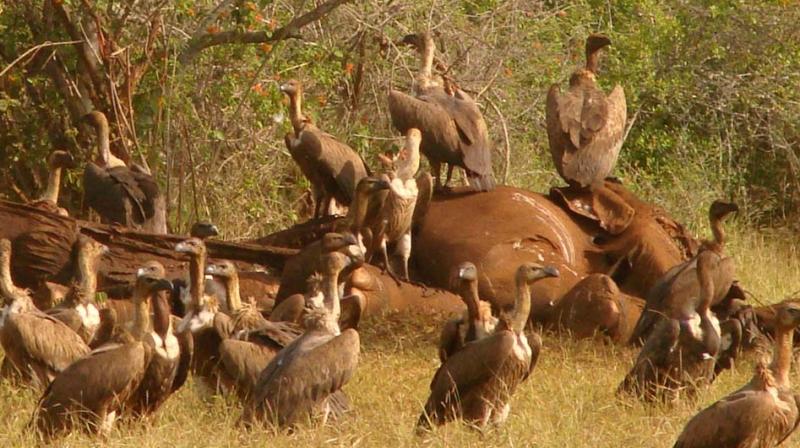September 1 Vulture Awareness Day: Vulture soars to survive
An endangered species not long ago, the big bird finds a promising rebirth hub in Moyar valley amid tiger reserve zone in Nilgiris.

Ooty: The population of vultures numbering only around 250 to 300 at Moyar Valley amidst the Mudumalai Tiger Reserve(MTR) buffer zone limits makes this place a very critical hub of the giant bird as vulture conservation, studies and research have been confined to this part of the state in the recent times. Vultures, nature's own sanitary squad, whose jungle scavenging works is helpful in keeping the woods clean and tidy, are also helpful to check spread of dreaded germs from the woods to the outside world.
Though vultures dominated the Indian skies, over the decades the eco-toxicological factors played havoc with the life of vultures. Its population not only declined rapidly over the decades, but had become a critically endangered species which needed highest level of conservation efforts. Of course, the population of vultures in Moyar valley is said to be the highest in the state. Certainly, the figure looks small, but, for the conservationists this population is indicative that vultures are returning to the hills.
Dr B. Ramakrishnan, assistant professor of Zoology and Wildlife Biology at Government Arts College here, who is a principal investigator of a research related to vulture biology in Moyar valley, said that statistics showed that by 1999 the vulture population in Nilgiris was almost wiped out as only a dozen was stated to be thriving in the hills then. But, over the past two decades, the population of vulture showed steady increase. Now an estimated population of around 250 to 300 healthy reproductive population of vulture is found to be thriving in Moyar Valley. Though it is a small number, certainly it is a good sign. Vulture is a slow breeding avian. It may take another decade for the present population in Moyar Valley to double its number, he explained.
Out of nine species of vultures in India, four species namely the White-Rumped Vulture, Long-Billed Vulture, Red-headed Vulture which is commonly called as Asian King Vulture and Egyptian vulture are found in different parts of South India. However, Moyar Valley is the only area wherein all these four species, which belong to old world vulture species, are found to thrive, he noted.
Vulture generally feed on putrefying carcass of the animals. Since, the carnivore population is very good in Moyar Valley as it is part of the MTR buffer zone, the prey base is very good for the vultures. Moreover, where ever tiger population increases, there is chance that vulture population will also show increase as the predating big cats bring good prey for the vultures in the jungles, he reasoned. Since, Moyar Valley is a good tiger landscape, one can expect that the existing vulture population would thrive well without any external and eco-toxicological disturbances as good conservation measures arebeing taken by the forest department now, Dr Ramakrishnan pointed out.
S. Bharathidasan, secretary of the Coimbatore-based Arulagam, an organisation which is committed towards vulture conservation and vulture studies, said that vulture population in Moyar Valley has begun to spread up to to Thengumarahada in the foot hills of Nilgiris as well as up to some parts of Sathyamangalam tiger reserve(STR) jungles in Erode district. In the coming years, the vulture population was expected to spread well in the STR, he hoped.

